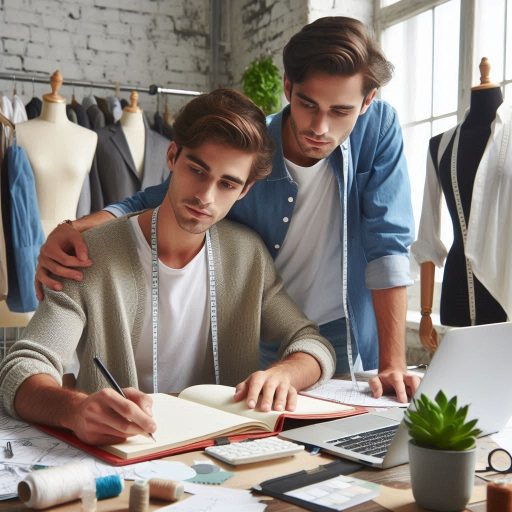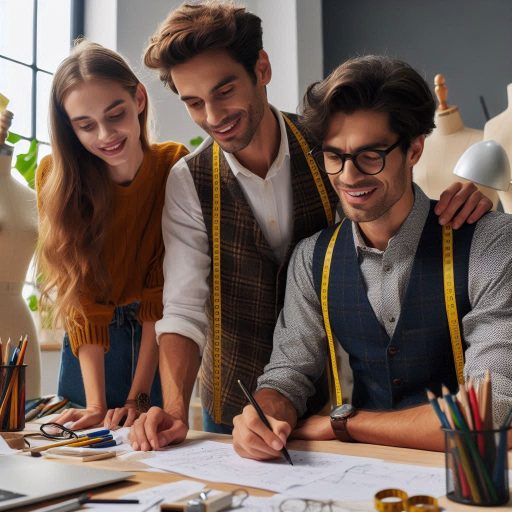Introduction
Fashion design runway shows are captivating events that showcase a designer‘s latest collections.
These shows present new trends, colors, and styles to the world.
Designers use runway shows to make bold statements and set the fashion agenda for the upcoming seasons.
Runway shows serve as a powerful platform for creativity and innovation.
They offer designers an opportunity to express their artistic vision and creativity.
Each show is meticulously planned, from the clothing and accessories to the choreography and music.
The significance of understanding runway shows extends beyond the glitz and glamour.
These events are crucial for industry professionals, including buyers, critics, and influencers.
Buyers use runway shows to decide which collections to stock in their stores.
Critics analyze the shows to predict future fashion trends.
Influencers and media spread the trends to the public, amplifying the designer‘s reach.
Fashion design runway shows also play a key role in shaping consumer preferences.
What appears on the runway often influences what becomes popular in retail stores.
Understanding these shows helps both fashion enthusiasts and professionals anticipate what will be in style next.
History of Runway Shows
Origins of Runway Shows in the Fashion Industry
Runway shows have become a cornerstone of the fashion industry, showcasing the latest trends and designs.
Their origins trace back to the early 20th century.
In the 1900s, fashion designers began using these shows to display their collections.
Initially, runway shows were private affairs, often held in salons or small venues.
Evolution of Runway Shows Over the Years
The concept of the runway show evolved significantly over time.
In the 1920s, designers like Coco Chanel started using runway shows to introduce their collections to a wider audience.
These shows gained prominence and became more elaborate, featuring live music and theatrical elements.
The 1950s marked a turning point for runway shows.
The rise of models and high fashion houses transformed the way these shows were conducted.
Designers such as Christian Dior and Yves Saint Laurent popularized elaborate, glamorous presentations.
The runway became a stage for showcasing not only clothing but also creativity and innovation.
In the 1980s and 1990s, runway shows continued to evolve.
The fashion industry embraced technology and multimedia.
Designers incorporated digital elements and special effects into their presentations.
These innovations added a new dimension to runway shows, making them more dynamic and engaging.
Impact of Runway Shows on the Fashion Industry
Today, runway shows have become a global phenomenon.
Major fashion weeks in cities like New York, Paris, Milan, and London set the stage for designers to unveil their latest collections.
These shows attract top fashion editors, celebrities, and influencers from around the world.
The impact of runway shows on the fashion industry is profound.
They drive trends and influence consumer behavior.
Designers use these shows to establish their brand identities and set the tone for the season.
The media coverage and social media presence of runway shows amplify their reach, shaping fashion trends worldwide.
Runway shows also offer a platform for emerging designers to gain recognition.
Many successful designers began their careers by showcasing their work in smaller, less-known fashion weeks.
This exposure can lead to significant opportunities and collaborations within the industry.
Runway shows have a rich history that reflects the evolution of the fashion industry.
From their humble beginnings to their current global prominence, these shows have played a crucial role in shaping fashion trends and influencing consumer preferences.
The dynamic nature of runway presentations continues to capture the imagination of audiences and drive the fashion industry forward.
Read: Top Skills Needed for Art Educators and Instructors
Elements of a Runway Show
Setting and Stage Design
set the scene for the runway show.
Designers use the stage to reflect the theme and mood of their collection.
Innovative settings transport the audience into a different world, enhancing the overall experience.
From minimalist stages to elaborate backdrops, every choice impacts how the collection is perceived.
A well-designed stage highlights the clothing while creating a memorable atmosphere.
Music and Lighting
Play a crucial role in setting the tone.
Music complements the theme of the collection, influencing the audience’s emotions and responses.
The rhythm and style of the music synchronize with the models’ movements, enhancing the overall performance.
Lighting accentuates the clothing and adds drama to the runway.
It can create shadows, highlight textures, and direct attention to key elements of the show.
Together, music and lighting craft an immersive experience.
Models and Their Walk
Bring the designer’s vision to life.
Each model‘s walk is tailored to fit the theme and style of the collection.
Confidence and poise are essential as models navigate the runway, showcasing the clothing in its best light.
A model‘s stride can convey elegance, strength, or playfulness, depending on the designer’s intent.
The walk ensures the audience focuses on the garments and their movement.
It transforms a static display into a dynamic presentation.
Clothing and Accessories Showcased
Are the main attractions of the runway show.
Designers carefully select garments and accessories to tell a story or convey a message.
Each piece is meticulously crafted, reflecting the designer‘s creativity and skill.
Accessories, from jewelry to hats, complement the clothing, adding layers of detail.
The combination of clothing and accessories showcases the designer‘s vision and creativity.
It allows the audience to see how each piece fits into the overall collection.
Basically, the elements of a runway show work together to create a cohesive and captivating experience.
The setting and stage design establish the visual backdrop.
Music and lighting enhance the atmosphere and mood.
Models’ walks highlight the clothing and bring it to life.
Clothing and accessories are the focal points, displaying the designer’s artistry.
Each element plays a vital role in the success of the runway show, leaving a lasting impression on the audience.
Role of Fashion Designers in Runway Shows
Fashion designers play a pivotal role in the success of runway shows.
Their influence spans from selecting models to crafting designs that captivate audiences.
Each element they manage contributes to the overall spectacle and impact of the show.
Selection of Models
Fashion designers carefully choose models to bring their vision to life.
They select individuals who embody the look and feel of their collection.
Models must fit the designer’s aesthetic, creating a cohesive presentation.
Designers often work with agencies to ensure their chosen models align with their brand’s image.
The right models enhance the collection’s presentation and amplify the designer’s vision.
Creation of Designs Specifically for the Runway
Designers craft their collections with the runway in mind.
They create pieces that stand out under the spotlight and captivate the audience.
Each design must not only look good up close but also make a statement from a distance.
Fabrics, colors, and silhouettes are chosen to make an impact.
Designers often experiment with bold styles and innovative techniques.
Their goal is to push boundaries and showcase their creativity.
Every piece is meticulously planned to ensure it contributes to a powerful runway experience.
Planning and Coordination of the Overall Show
Fashion designers oversee the entire production of their runway shows.
They work closely with various teams to coordinate every detail.
This includes working with stylists, makeup artists, and choreographers.
Designers must ensure that all elements align with their creative vision.
They plan the sequence of the show, including the order in which models will walk.
Lighting and music are also selected to complement the designs.
Timing is crucial; designers need to ensure that everything runs smoothly and on schedule.
In summary, fashion designers are integral to the success of runway shows.
Their roles encompass selecting models, creating eye-catching designs, and coordinating all aspects of the show.
Each decision they make influences the overall impact and perception of their collection.
Through their expertise and creativity, designers transform their visions into memorable runway experiences.
Their efforts ensure that each show is not just a presentation but a showcase of artistry and innovation.
Read: Collaborating with Other Creative Roles
Audience and Press at Runway Shows
Types of Audience Members Present
Runway shows attract a wide range of attendees, each bringing unique perspectives and contributions.
The audience primarily consists of fashion insiders such as buyers and editors.
These individuals play a crucial role in determining which collections will make it to stores and magazines.
Buyers are looking for pieces that will resonate with their customers and generate sales, while editors are scouting for trends to feature in upcoming issues.
Influencers and bloggers are also key members of the audience.
Their presence extends the reach of the runway show beyond the physical event, as they share their experiences and highlights with their followers on social media.
Fashion enthusiasts and students add another layer to the audience.
They attend to gain inspiration and insight into the latest trends and techniques, often hoping to make connections and learn from industry leaders.
Together, these diverse groups create a dynamic environment that reflects the multifaceted nature of the fashion industry.
Importance of Press Coverage for Designers
Press coverage holds immense value for designers, acting as a bridge between their creations and the public.
Journalists and media outlets provide essential exposure, which can significantly impact a designer‘s success.
Positive reviews and feature articles can generate substantial buzz and build a designer‘s reputation.
Conversely, negative coverage can have detrimental effects, potentially hindering a designer‘s career.
The narratives crafted by the press help shape public perception and can influence consumer behavior.
Designers rely on media to amplify their collections, reaching a broader audience and gaining recognition.
Coverage in high-profile publications can lead to increased sales and brand recognition, making press engagement a critical aspect of a successful runway show.
Effective press coverage not only highlights the collection but also contributes to the designer‘s overall brand image and market position.
Influence of Celebrity Presence at Runway Shows
The presence of celebrities at runway shows has a profound impact on both the event and the designer.
Celebrities draw significant media attention, often becoming the focal point of coverage.
Their attendance can overshadow the collection itself, but it also provides a valuable endorsement.
When a well-known figure supports a designer, it lends credibility and increases the designer‘s visibility.
The celebrity‘s influence extends beyond the runway, as their endorsement can boost a designer‘s appeal and attract new customers.
Their presence often signals high status and adds a layer of glamour to the event.
In many cases, celebrities help to validate a designer‘s work, making it more attractive to potential buyers and the media.
Overall, the influence of celebrities at runway shows plays a crucial role in shaping public perception and enhancing the designer‘s reputation.
Essentially, runway shows are more than just fashion showcases.
They involve a strategic mix of audience engagement, press interaction, and celebrity influence.
Each component plays a vital role in determining the success of a designer‘s collection and establishing their presence in the fashion world.
Read: Historic Costume Design Inspirations

Trend Forecasting at Runway Shows
How Runway Shows Influence Fashion Trends
Runway shows are pivotal events in the fashion industry, setting the stage for the trends that will dominate upcoming seasons.
Designers unveil their collections with bold creativity and innovative styles, generating substantial buzz and media coverage.
Each runway show provides a glimpse into the future of fashion, showcasing the colors, fabrics, and silhouettes that will define the next season.
Fashion insiders, including editors, influencers, and buyers, attend these shows to observe and critique the latest trends.
Their observations and reactions often shape the way these trends are perceived and adopted.
For example, a runway show featuring vibrant neon colors or oversized silhouettes can signal the rise of these elements in everyday fashion.
As such, runway shows are not just displays of artistic expression but critical moments that influence fashion trends on a global scale.
Role of Trend Forecasting Agencies in Analyzing Runway Shows
Trend forecasting agencies are essential in translating the raw data from runway shows into actionable insights.
These agencies specialize in analyzing the myriad of details presented during fashion week.
They examine each collection for recurring themes, innovative fabrics, and distinctive cuts.
By analyzing multiple shows and identifying patterns, trend forecasters create comprehensive reports that predict upcoming trends.
Their expertise allows them to forecast not just specific styles but broader movements within the fashion industry.
For example, they might predict a shift towards sustainable materials or the resurgence of vintage styles.
These trend reports are invaluable to fashion brands, guiding their design processes and helping them align their collections with anticipated trends.
As a result, trend forecasting agencies play a crucial role in bridging the gap between the runway and the consumer market.
Transform Your Career Today
Unlock a personalized career strategy that drives real results. Get tailored advice and a roadmap designed just for you.
Start NowImpact on Consumer Behavior
The influence of runway shows extends beyond the fashion industry and significantly impacts consumer behavior.
Once trends are identified and forecasted, they begin to appear in retail stores and online marketplaces.
Fashion brands, informed by trend reports, adjust their product lines to reflect the latest styles.
Consumers, inspired by what they see on the runway and in trend reports, start seeking out similar looks.
The visibility of these trends is further enhanced by endorsements from celebrities and influencers, who wear and promote the latest styles.
This endorsement can accelerate the adoption of new trends, driving consumer demand.
As a result, purchasing habits evolve, with consumers becoming more open to experimenting with new styles and incorporating trendy elements into their wardrobes.
The cyclical nature of fashion means that as new trends emerge, they often influence subsequent trends, creating a dynamic and ever-changing fashion landscape.
Thus, runway shows and trend forecasting agencies play a crucial role in shaping and predicting consumer behavior in the fashion industry.
Read: Breaking Down Iconic Movie Costumes
See Related Content: The Role of Lighting Designers in Event Planning
Diversity and Inclusivity in Runway Shows
Progress towards more diverse representation on the runway:
Over the years, there has been a noticeable shift towards more diversity in fashion design runway shows.
Designers, brands, and organizers are starting to recognize the importance of representing a variety of backgrounds, cultures, and body types in their presentations.
Many fashion industry insiders and consumers have been vocal about the need for better representation on the runway.
This push for diversity has led to positive changes in the industry, with more models of different ethnicities, sizes, ages, and genders walking in shows.
Diversity in runway shows not only reflects the real world but also sends a powerful message about inclusivity and acceptance.
It allows people from all walks of life to see themselves represented in the fashion world, which can have a significant impact on self-esteem and confidence.
Designers are also realizing that showcasing diversity in their collections can attract a wider audience and help their brands stand out in a crowded market.
Inclusivity is no longer just a trend but a fundamental value that resonates with consumers who want to see themselves reflected in the brands they support.
Challenges faced in promoting inclusivity
While there have been strides towards greater diversity in fashion design runway shows, there are still significant challenges to overcome.
One major obstacle is the long-standing tradition of favoring a narrow definition of beauty in the industry.
Some designers and casting directors continue to hold onto outdated beliefs about what is considered attractive or marketable.
Which can limit the opportunities for models who don’t fit into that narrow mold.
This can be discouraging for aspiring models who don’t see themselves represented in mainstream fashion.
Another challenge is the lack of inclusivity behind the scenes in the fashion industry.
Many brands and fashion houses still struggle with diversity in their design teams, decision-makers, and executives.
Without diverse voices at every level of the industry, it can be challenging to create truly inclusive and representative runway shows.
Additionally, there is a need for more education and awareness around issues of diversity and inclusivity in fashion.
Some designers may not know how to approach casting diverse models or fear backlash if they do so.
Addressing these concerns requires a shift in mindset and a commitment to challenging the status quo.
Importance of showcasing diversity in fashion design:
Embracing diversity in fashion design runway shows is not just about meeting a quota or checking a box.
It is about creating a more inclusive and representative industry that celebrates the uniqueness of individuals from all backgrounds.
By showcasing diversity on the runway, designers have the opportunity to inspire and empower people of all ages, sizes, and identities.
Moreover, promoting inclusivity in fashion design can lead to greater innovation and creativity.
When designers embrace different perspectives and experiences, they can create collections that resonate with a wider audience and push boundaries in terms of style, aesthetics, and storytelling.
Diversity breeds creativity, and by embracing a diverse range of models and talents, designers can elevate their work to new heights.
Ultimately, showcasing diversity in fashion design runway shows is not just a trend; it’s a responsibility.
It’s a chance for the industry to lead by example and show the world that beauty comes in all shapes, sizes, colors, and identities.
By promoting inclusivity and embracing diversity, fashion designers can make a positive impact on society and pave the way for a more inclusive future.
Conclusion
Fashion design runway shows are not just glamorous events; they are pivotal moments in the fashion industry.
This blog has explored how runway shows serve as a platform for designers to showcase their latest collections.
We’ve seen how these events impact trends, build brand identity, and drive media attention.
Runway shows provide designers with a stage to present their creativity and innovation.
They allow designers to display their work to an audience that includes buyers, press, and fashion influencers.
This visibility can significantly boost a designer’s career and brand recognition.
We also discussed the critical role of press coverage.
Media outlets report on runway shows, shaping public perception and influencing consumer trends.
Positive reviews from reputable fashion critics can lead to increased sales and media exposure.
Additionally, the presence of celebrities and influencers at runway shows can amplify the event’s reach.
Their involvement often generates buzz and attracts attention from a broader audience.
This kind of exposure is invaluable for designers looking to establish their presence in the industry.
[E-Books for Sale]
The Big Book of 500 High-Paying Jobs in America: Unlock Your Earning Potential
$19.99 • 500 High-Paying Jobs • 330 pages
Explore 500 high-paying jobs in America and learn how to boost your career, earn more, and achieve success!
See All 500 High-Paying Jobs of this E-Book
1001 Professions Without a Degree: High-Paying American Jobs You Can Start Now
$19.99 • 1001 Professions Without a Degree • 174 pages
Discover 1001 high-paying jobs without a degree! Unlock career tips, skills, and success strategies for just $19.99!




